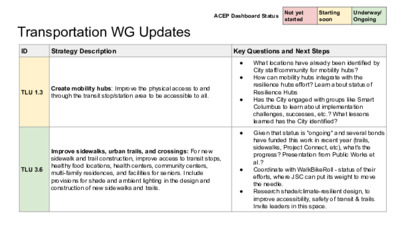6. Transportation Working Group Update — original pdf
Backup

Transportation WG Updates ID Strategy Description Key Questions and Next Steps ACEP Dashboard Status Not yet started Starting soon Underway/ Ongoing TLU 1.3 Create mobility hubs: Improve the physical access to and through the transit stop/station area to be accessible to all. TLU 3.6 Improve sidewalks, urban trails, and crossings: For new sidewalk and trail construction, improve access to transit stops, healthy food locations, health centers, community centers, multi-family residences, and facilities for seniors. Include provisions for shade and ambient lighting in the design and construction of new sidewalks and trails. ● ● ● ● ● ● What locations have already been identified by City staff/community for mobility hubs? How can mobility hubs integrate with the resilience hubs effort? Learn about status of Resilience Hubs Has the City engaged with groups like Smart Columbus to learn about implementation challenges, successes, etc.? What lessons learned has the City identified? Given that status is "ongoing" and several bonds have funded this work in recent year (trails, sidewalks, Project Connect, etc), what's the progress? Presentation from Public Works et al.? Coordinate with WalkBikeRoll - status of their efforts, where JSC can put its weight to move the needle. Research shade/climate-resilient design, to improve accessibility, safety of transit & trails. Invite leaders in this space. ID Strategy Description Key Questions and Next Steps TE 1.1 Conduct an EV Community Needs Assessment: Work with local community partners, grassroots organizations, and connection points like the Austin Energy Customer Assistance Program and the City’s affordable housing programs. TE 1.2 Create equitable incentives for buying and leasing EVs: Collaborate with community partners to create inclusive and easily accessible incentives for buying or leasing electric vehicles. This strategy would supplement existing state and federal programs, prioritize low-income communities and communities of color and focus on geographic areas with limited or no access to transit. TE 1.4 Launch an e-bike and electric car-sharing program: Be intentional and equity-focused when considering where to install car sharing locations, what types of vehicles to include, and how to accept payment ● What are obstacles to this starting? ● At AE presentation, ask about EV charging infrastructure in Austin - where will it be located? In multifamily housing? How is equity factored into this? Possible rec: Allocate funding for staff/consultant to conduct the assessment. The ACEP Dashboard states that additional research is needed to identify possible funding sources for increased EV incentives. What is the status of this research? What options is AE or the City exploring? ACEP Dashboard mentions a car sharing pilot in discovery phase for multifamily properties. What is the status of that project? Has the City engaged with groups like Forth or BlueLA to understand implementation challenges and successes for EV car-sharing? What lessons learned has the City identified from leading organizations? ● ● ● ● ACEP Dashboard Status Not yet started Starting soon Underway/ Ongoing ID Strategy Description Key Questions and Next Steps TE 2.1 Create a network with more low-cost, accessible charging stations: Prioritize areas that have been systematically excluded, such as existing multi-family properties, parks, community centers, libraries, geographically under-represented areas, and low-income communities and communities of color while mitigating displacement. Work with diverse and representative community partners to continuously improve plans. TE 2.1 Create a network with more low-cost, accessible charging stations: Fill in gaps by installing EV charging on publicly owned land in systematically excluded areas, and address maintenance and ongoing support for charging stations. TE 2.4 Expand outreach to systematically excluded groups: Focus on clarifying the EV charging process, raise awareness about available incentives and increase community involvement. ● What steps has Austin Energy or the City taken to formally identify areas of high need that require additional EV charging access? ● How would the EV Community Needs Assessment inform action on these strategies? ● What would be the most effective way to promote EV education/awareness to the community and how can JSC better help with this? Additional strategies considered by WG ID Strategy Description Key Questions and Next Steps TLU 3.2 Promote free transportation options: Expand free transit options, including through Capital Metro, to provide increased transportation access for low-income communities, communities of color, and people with disabilities. ● What is the current status of conversations around fare-free transit within Capital Metro? ● What lessons learned has the City identified based on other communities’ experiences with fare-free transit?